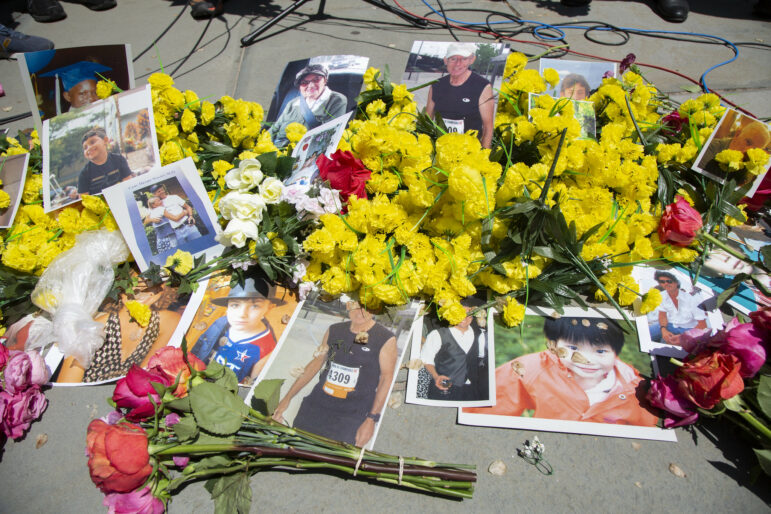“After Cooper was killed, I wanted to believe that his death would have meaning. However, as I have watched 100 other children suffer a similar fate, I can’t help but feel that our city continues to fail our kids. More than 60 percent of the children killed were pedestrians, and a third were walking to or from school.”

John McCarten/NYC Council
A vigil set up outside City Hall in 2019 to honor New Yorkers killed in traffic violence that year.On July 3, a 16-year-old and a 15-year-old passenger were killed in a crash. They were the 100th and 101st children killed in New York City’s Vision Zero Era. My son, Cooper Stock, was the first.
On January 10, 2014, 9-year-old Cooper was killed crossing the street. He was holding his father’s hand as they walked home. Together, they waited for the walk sign, crossing only when it lit up white. A taxi driver turned left onto West End Avenue, speeding through the crosswalk, hitting and killing my son while his father watched.
Cooper was the life of the party even when there wasn’t a party. His fellow third graders adored his wicked sense of humor and respected him for his kindness and compassion. A vision that will haunt me forever is seeing his classmates holding one another, their eyes filled with tears and their small bodies trembling. Their childhoods ended abruptly—each time a child is killed, there are hundreds more left behind to suffer, their lives permanently changed.
Our son’s death brought unique, unknowable pain to myself and my husband—but it’s not an unusual loss in our city. The silent epidemic of New Yorkers killed by cars led the city to launch Vision Zero—an initiative to end traffic deaths and serious injuries—back in 2014.
Vision Zero is predicated on two facts: no traffic deaths are acceptable, and traffic crashes are not accidents, but the result of policy and design choices. If we design safe streets and control the potential harm of automobiles, we can protect everyone.
Unfortunately, press conferences and studies mean nothing without action or change.
My son would be counted as the first child killed in the Vision Zero era—but far from the last. As of today, 100 other children have been killed. That is 100 other parents suffering through the very worst day of their lives, 100 other communities destroyed, 100 other families waiting for the city they call home to take action.
After Cooper was killed, I wanted to believe that his death would have meaning. However, as I have watched 100 other children suffer a similar fate, I can’t help but feel that our city continues to fail our kids. More than 60 percent of the children killed were pedestrians, and a third were walking to or from school.
It’s not Vision 100—or Vision 2,260, the total number of people killed in traffic crashes since 2014—and it’s time for the city to step in before the next child is killed. Mayor Eric Adams promised to eliminate traffic fatalities, but in his first year we saw a rise in child fatalities and car ownership in ever larger and more dangerous vehicles.
Our elected leaders must build streets for kids and put an end to the deadly arms race among ever larger, heavier, deadlier vehicles. More vehicles, heavier footprints, and bigger blindspots increase the likelihood that crashes kill, especially children.
We can and must design our streets to improve visibility for the smallest pedestrians, block cars from roads around schools during drop-off and pick-up times, and incentivize purchasing smaller vehicles. We know what works, and New York City’s leaders must treat this crisis with the urgency it deserves.
Mayor Adams calls himself the “get stuff done” mayor. A decade after Cooper’s death—and just a month after he should have graduated high school—the mayor must prove that those are more than just empty words.
Watching his friends grow up when Cooper is dead is an agony that has brought me to my knees. The pain remains constant—it has not gone away and it never will.
Dana Lerner is the mother of the first child killed under New York City’s Vision Zero.








One thought on “Opinion: More Than 100 Children Have Died in NYC Traffic Crashes Since Vision Zero Launch”
How many drivers who caused these children’s death were using Assigned Risk Plan insurance?
Where is this information available to the public?